Abstract
Live attenuated Francisella tularensis vaccine induced long-lasting humoral and cell-mediated immune responses in all 13 subjects studied. Lymphocyte blast transformation reactivity to F. tularensis appeared 2 weeks after vaccination in most subjects and remained unchanged for up to 1.5 years. Similarly, in most recipients, antibodies against F. tularensis were detectable by both the enzyme-linked immunosorbent assay (ELISA) and the agglutination method from 2 weeks after vaccination, although diagnostically significant agglutination titers (greater than or equal to 80) were not detectable until 4 weeks after vaccination. Maximal agglutination titers of 80 to 2,560 appeared at 4 to 8 weeks, and in spite of decreasing tendency, titers as high as 320 were still present 1.5 years after vaccination. ELISA showed the simultaneous, but not parallel, appearance of different immunoglobulin classes, immunoglobulin M (IgM) reaching individual maximal values 1.8 months after vaccination on average, at the same time as agglutinating antibodies, 1 week earlier than IgA, and about 1 month earlier than IgG. All of these immunoglobulin classes persisted in significant amounts up to 1.5 years, with IgG generally dominant. Long-lasting IgA and IgM responses after vaccination, as also after infection, suggested that the serodiagnosis of tularemia generally requires two consecutive serum samples with a significant increase in the titer.
Full text
PDF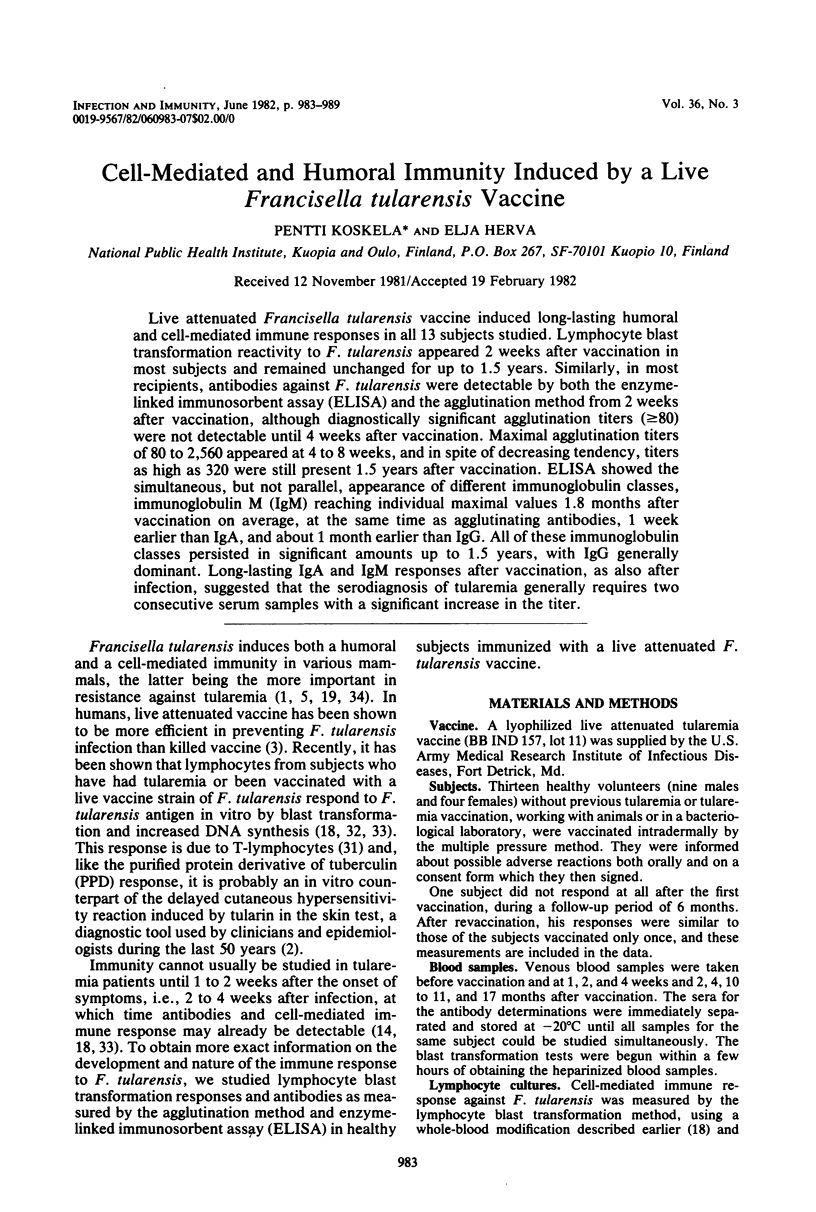
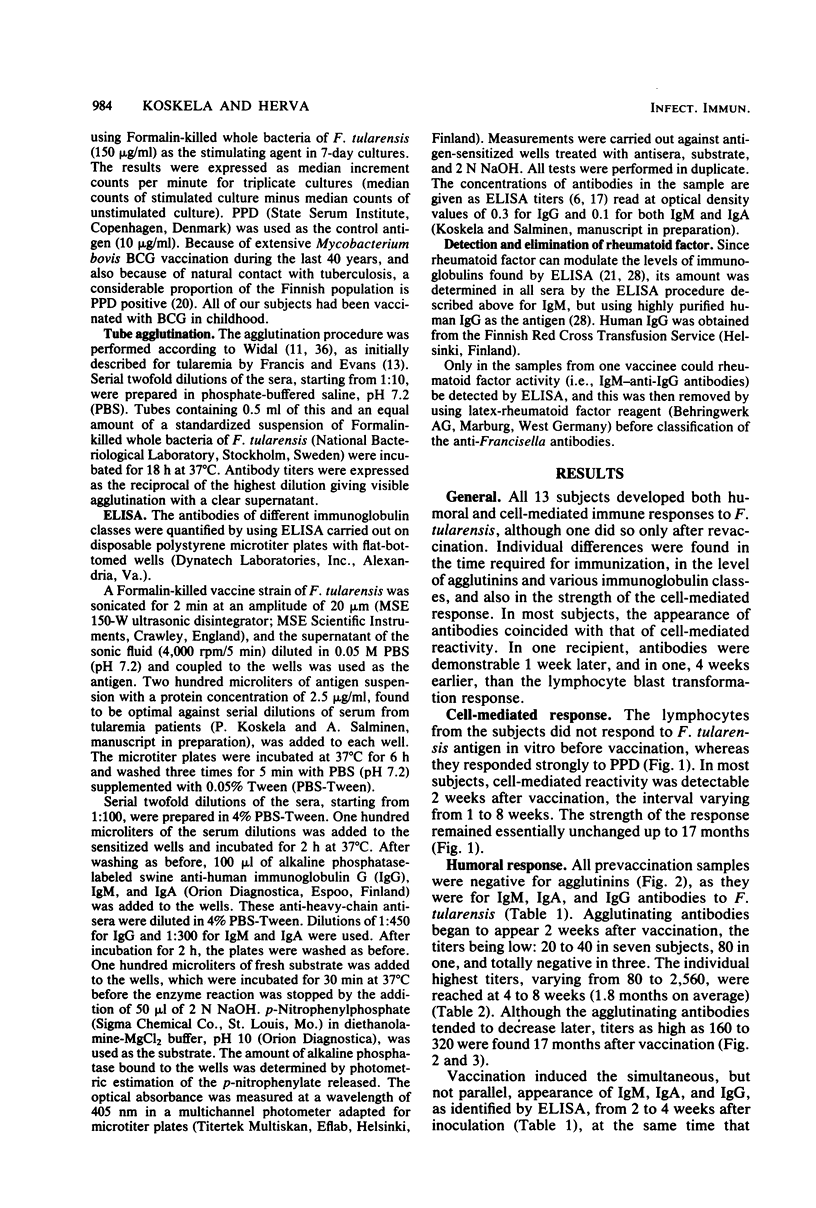
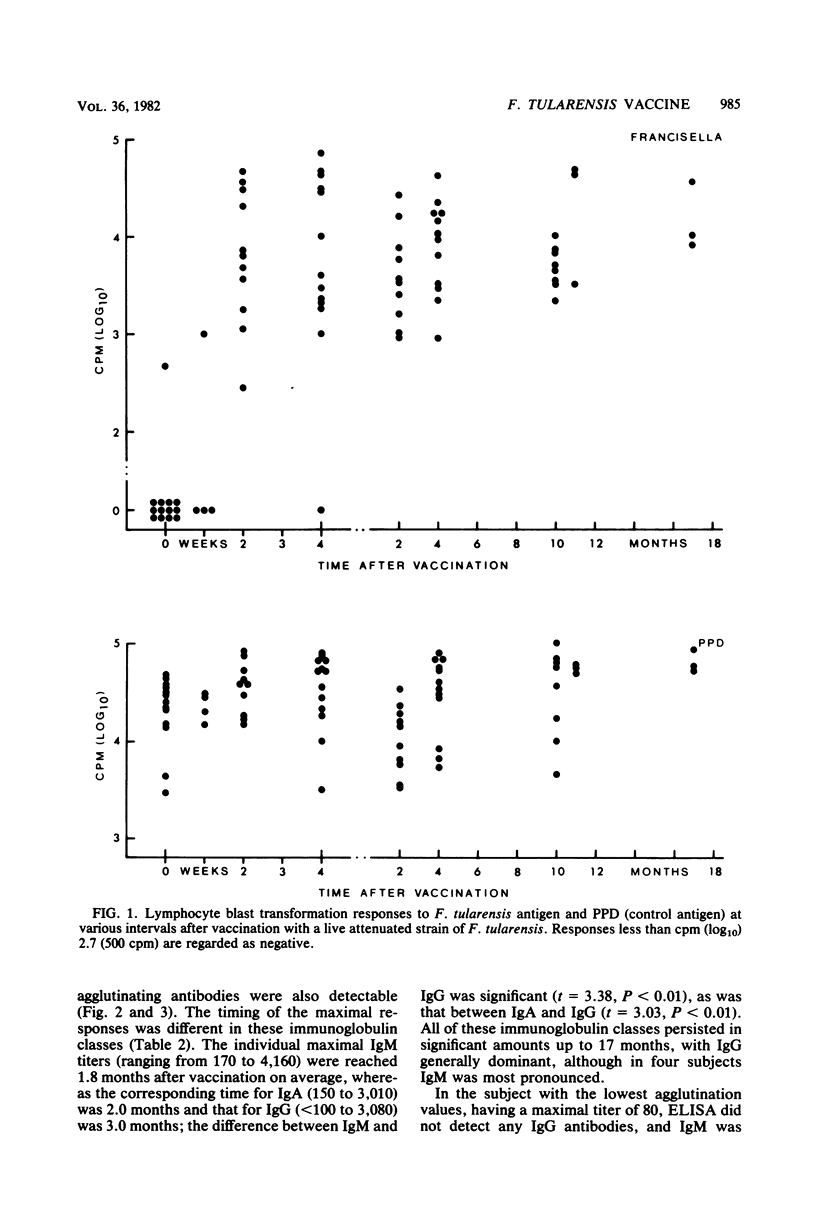
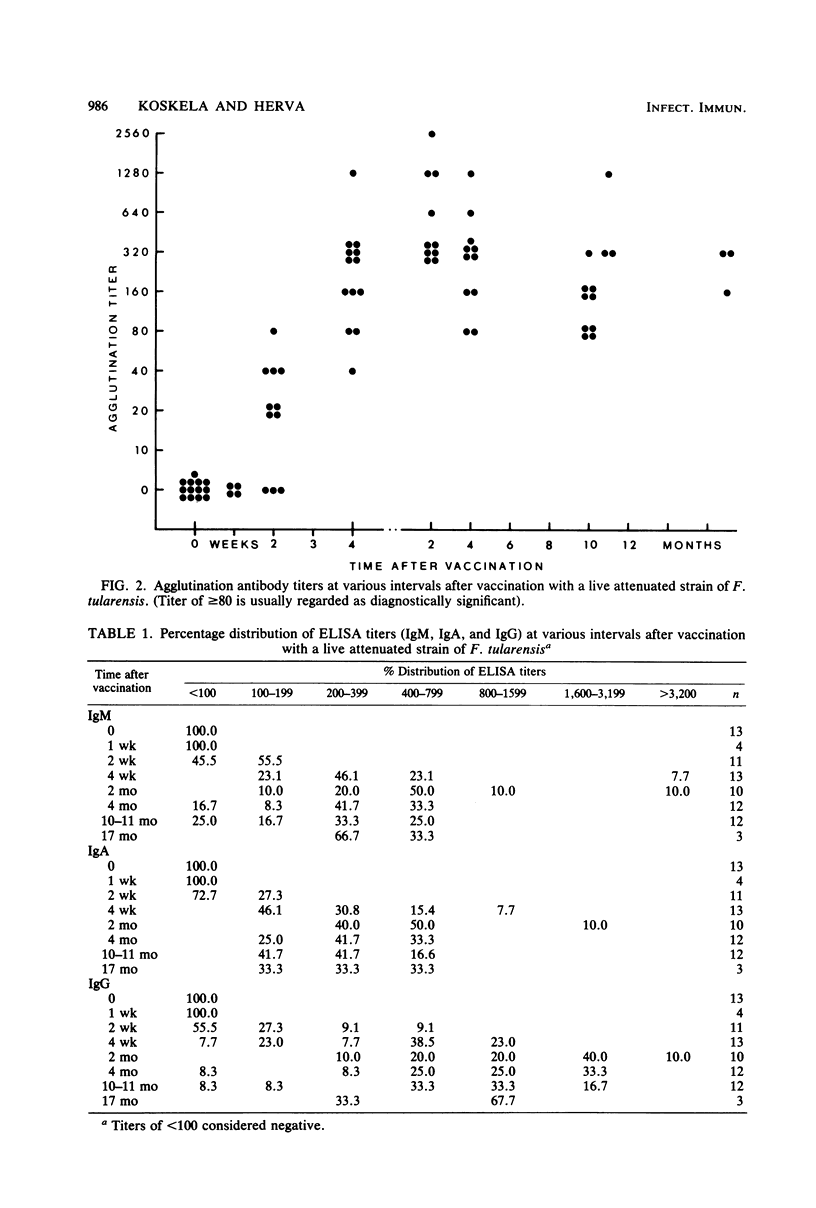
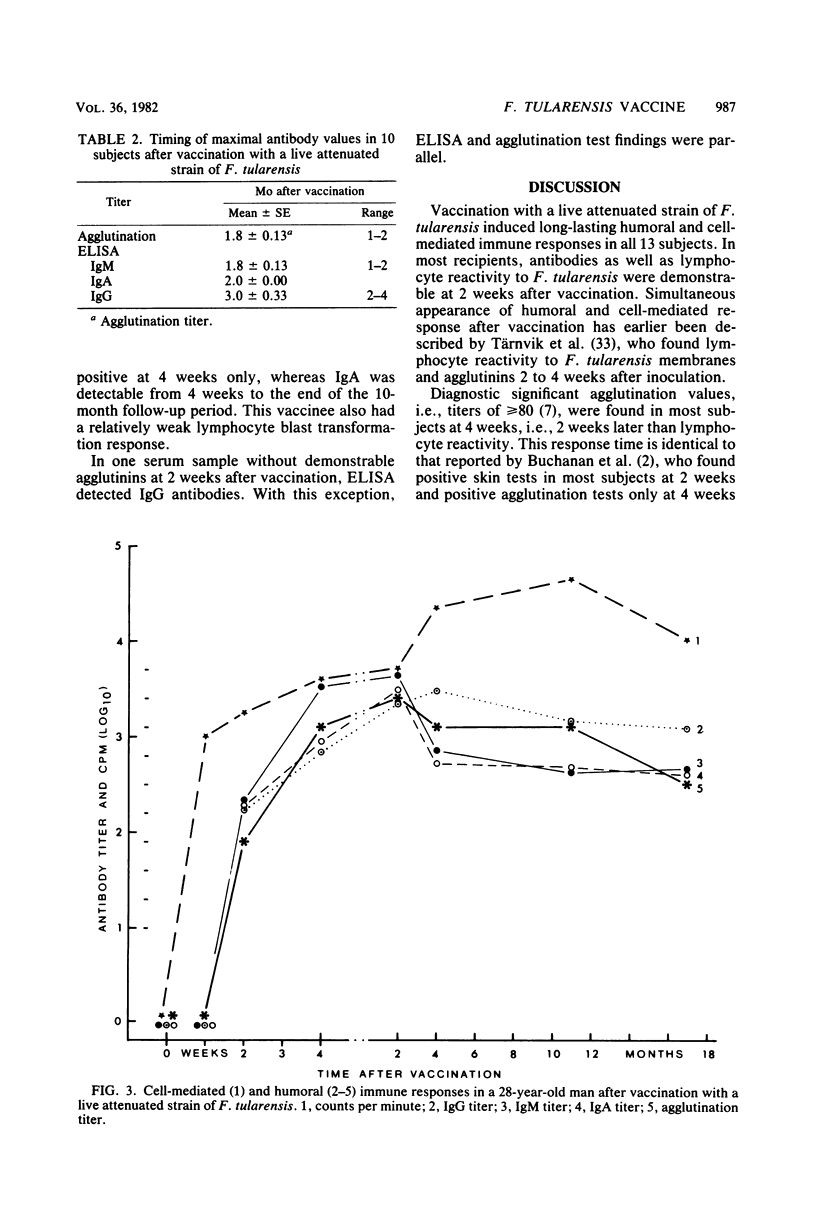
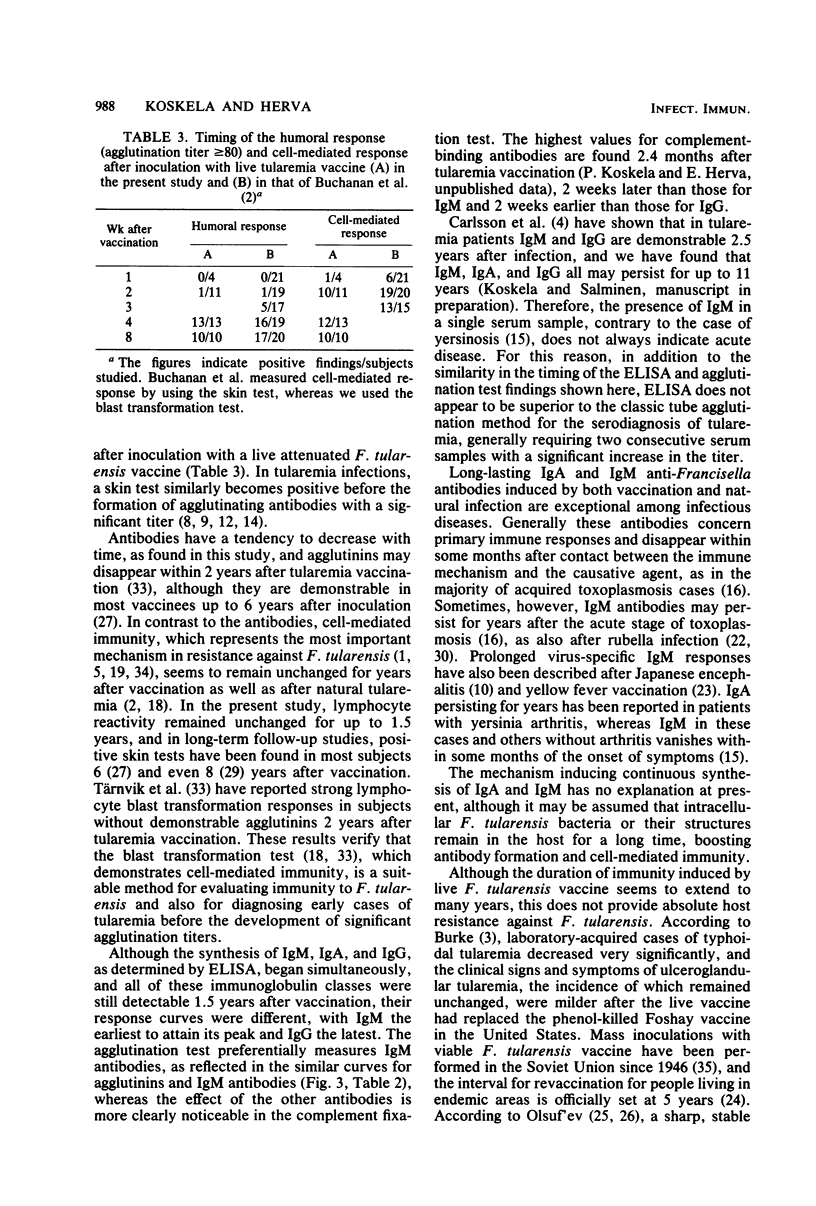
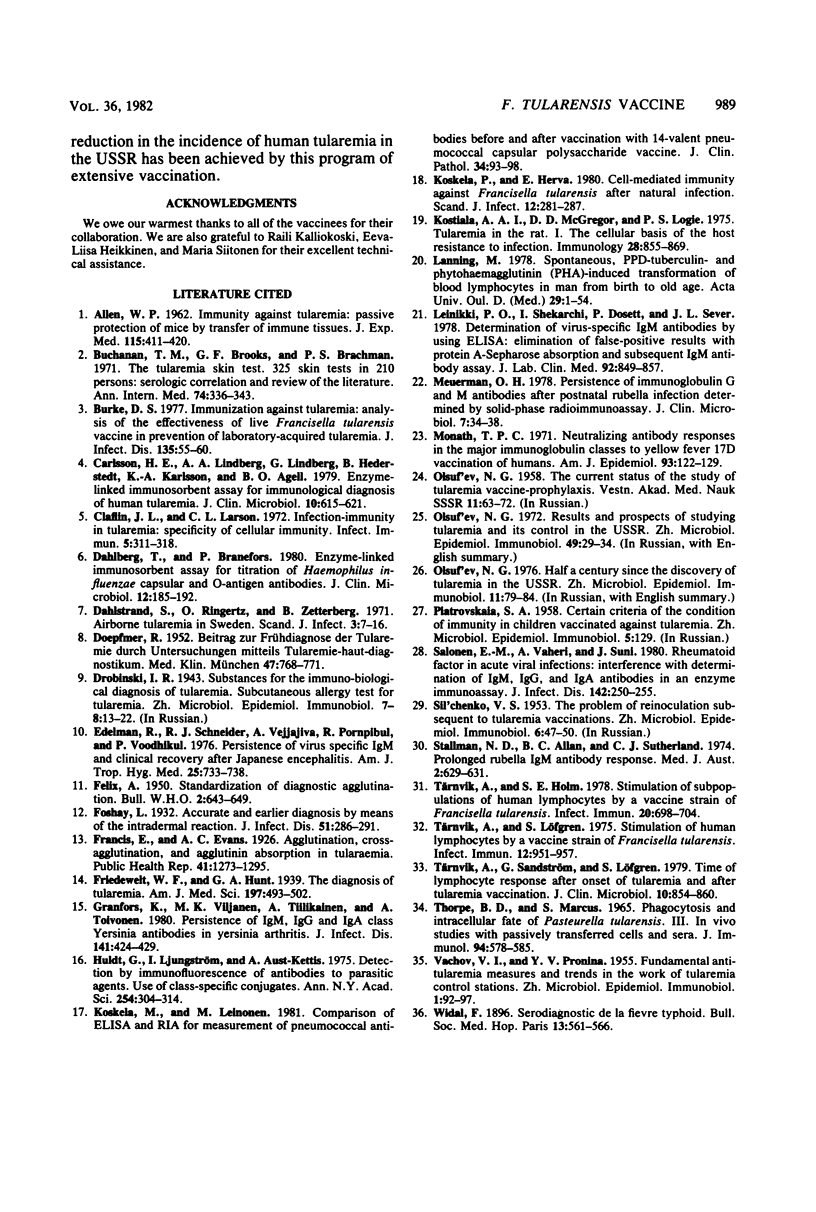
Selected References
These references are in PubMed. This may not be the complete list of references from this article.
- ALLEN W. P. Immunity against tularemia: passive protection of mice by transfer of immune tissues. J Exp Med. 1962 Feb 1;115:411–420. doi: 10.1084/jem.115.2.411. [DOI] [PMC free article] [PubMed] [Google Scholar]
- Buchanan T. M., Brooks G. F., Brachman P. S. The tularemia skin test. 325 skin tests in 210 persons: serologic correlation and review of the literature. Ann Intern Med. 1971 Mar;74(3):336–343. doi: 10.7326/0003-4819-74-3-336. [DOI] [PubMed] [Google Scholar]
- Burke D. S. Immunization against tularemia: analysis of the effectiveness of live Francisella tularensis vaccine in prevention of laboratory-acquired tularemia. J Infect Dis. 1977 Jan;135(1):55–60. doi: 10.1093/infdis/135.1.55. [DOI] [PubMed] [Google Scholar]
- Carlsson H. E., Lindberg A. A., Lindberg G., Hederstedt B., Karlsson K. A., Agell B. O. Enzyme-linked immunosorbent assay for immunological diagnosis of human tularemia. J Clin Microbiol. 1979 Nov;10(5):615–621. doi: 10.1128/jcm.10.5.615-621.1979. [DOI] [PMC free article] [PubMed] [Google Scholar]
- Claflin J. L., Larson C. L. Infection-immunity in tularemia: specificity of cellular immunity. Infect Immun. 1972 Mar;5(3):311–318. doi: 10.1128/iai.5.3.311-318.1972. [DOI] [PMC free article] [PubMed] [Google Scholar]
- DOEPFMER R. Beitrag zur Frühdiagnose der Tularämie durch Untersuchungen mittels Tularämie-Hautdiagnostikum. Med Klin. 1952 Jun 6;47(23):768–771. [PubMed] [Google Scholar]
- Dahlberg T., Branefors P. Enzyme-linked immunosorbent assay for titration of Haemophilus influenzae capsular and O antigen antibodies. J Clin Microbiol. 1980 Aug;12(2):185–192. doi: 10.1128/jcm.12.2.185-192.1980. [DOI] [PMC free article] [PubMed] [Google Scholar]
- Dahlstrand S., Ringertz O., Zetterberg B. Airborne tularemia in Sweden. Scand J Infect Dis. 1971;3(1):7–16. doi: 10.3109/inf.1971.3.issue-1.02. [DOI] [PubMed] [Google Scholar]
- Edelman R., Schneider R. J., Vejjajiva A., Pornpibul R., Voodhikul P. Persistence of virus-specific IgM and clinical recovery after Japanese encephalitis. Am J Trop Med Hyg. 1976 Sep;25(5):733–738. doi: 10.4269/ajtmh.1976.25.733. [DOI] [PubMed] [Google Scholar]
- FELIX A. Standardization of diagnostic agglutination tests; typhoid and paratyphoid A and B fevers. Bull World Health Organ. 1950;2(4):643–649. [PMC free article] [PubMed] [Google Scholar]
- Granfors K., Viljanen M., Tiilikainen A., Toivanen A. Persistence of IgM, IgG, and IgA antibodies to Yersinia in yersinia arthritis. J Infect Dis. 1980 Apr;141(4):424–429. doi: 10.1093/infdis/141.4.424. [DOI] [PubMed] [Google Scholar]
- Huldt G., Ljungström I., Aust-Kettis A. Detection by immunofluorescence of antibodies to parasitic agents. Use of class-specific conjugates. Ann N Y Acad Sci. 1975 Jun 30;254:304–314. doi: 10.1111/j.1749-6632.1975.tb29180.x. [DOI] [PubMed] [Google Scholar]
- Koskela M., Leinonen M. Comparison of ELISA and RIA for measurement of pneumococcal antibodies before and after vaccination with 14-valent pneumococcal capsular polysaccharide vaccine. J Clin Pathol. 1981 Jan;34(1):93–98. doi: 10.1136/jcp.34.1.93. [DOI] [PMC free article] [PubMed] [Google Scholar]
- Koskela P., Herva E. Cell-mediated immunity against Francisella tularensis after natural infection. Scand J Infect Dis. 1980;12(4):281–287. doi: 10.3109/inf.1980.12.issue-4.08. [DOI] [PubMed] [Google Scholar]
- Kostiala A. A., McGregor D. D., Logie P. S. Tularaemia in the rat. I. The cellular basis on host resistance to infection. Immunology. 1975 May;28(5):855–869. [PMC free article] [PubMed] [Google Scholar]
- Leinikki P. O., Shekarchi I., Dorsett P., Sever J. L. Determination of virus-specific IgM antibodies by using ELISA: elimination of false-positive results with protein A-Sepharose absorption and subsequent IgM antibody assay. J Lab Clin Med. 1978 Dec;92(6):849–857. [PubMed] [Google Scholar]
- Meurman O. H. Persistence of immunoglobulin G and immunoglobulin M antibodies after postnatal rubella infection determined by solid-phase radioimmunoassay. J Clin Microbiol. 1978 Jan;7(1):34–38. doi: 10.1128/jcm.7.1.34-38.1978. [DOI] [PMC free article] [PubMed] [Google Scholar]
- Monath T. P. Neutralizing antibody responses in the major immunoglobulin classes to yellow fever 17D vaccination of humans. Am J Epidemiol. 1971 Feb;93(2):122–129. doi: 10.1093/oxfordjournals.aje.a121232. [DOI] [PubMed] [Google Scholar]
- Public Health Weekly Reports for JUNE 25, 1926. Public Health Rep. 1926 Jun 25;41(26):1273–1339. [PMC free article] [PubMed] [Google Scholar]
- Salonen E. M., Vaheri A., Suni J., Wager O. Rheumatoid factor in acute viral infections: interference with determination of IgM, IgG, and IgA antibodies in an enzyme immunoassay. J Infect Dis. 1980 Aug;142(2):250–255. doi: 10.1093/infdis/142.2.250. [DOI] [PubMed] [Google Scholar]
- Stallman N. D., Allan B. C., Sutherland C. J. Prolonged rubella IgM antibody response. Med J Aust. 1974 Oct 26;2(17):629–631. [PubMed] [Google Scholar]
- THORPE B. D., MARCUS S. PHAGOCYTOSIS AND INTRACELLULAR FATE OF PASTEURELLA TULARENSIS. 3. IN VIVO STUDIES WITH PASSIVELY TRANSFERRED CELLS AND SERA. J Immunol. 1965 Apr;94:578–585. [PubMed] [Google Scholar]
- Tärnvik A., Holm S. E. Stimulation of subpopulations of human lymphocytes by a vaccine strain of Francisella tularensis. Infect Immun. 1978 Jun;20(3):698–704. doi: 10.1128/iai.20.3.698-704.1978. [DOI] [PMC free article] [PubMed] [Google Scholar]
- VASHKOV V. I., PRONINA E. V. Osnovnye protivotuliaremiinye meropriiataiia i napravleniia v rabote protivotuliaremiinykh stantsii. Zh Mikrobiol Epidemiol Immunobiol. 1955 Jan;1:92–97. [PubMed] [Google Scholar]


